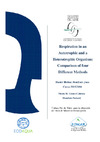Please use this identifier to cite or link to this item:
https://accedacris.ulpgc.es/jspui/handle/10553/18442
| Title: | Respiration in an autotrophic and a heterotrophic organism: comparison of four different methods | Other Titles: | Estudio comparativo de la respiración en organismos autotróficos y heterotróficos a partir de diferentes métodos | Authors: | Bondyale Juez, Daniel Rickue | Director: | Gómez Cabrera, María Milagrosa Packard, Theodore Train |
UNESCO Clasification: | 2510 Oceanografía | Keywords: | Respiración Organismos autotróficos Organismos heterotróficos |
Issue Date: | 2016 | Project: | Metabolismo planctónico: Regulación Bioquímica e Impacto Oceanográfico sobre la Bomba Biológica | Abstract: | In the following research we studiedthe differences between the respiratory behavior of an autotrophic and a heterotrophic organism while at the same time comparingdifferent respiration measurement techniques. The respiration methodologies were the Winkler method, oxygen electrodes, oxygenoptodes and the kinetic assay for the respiratoryelectron transport system (ETS), methods that allow the determination of both physiological and enzymatic respiration. The organisms chosen for these experiments were a coastal crustacean, the mysid Leptomysis lingvura, and a coastal macroalgae, the chlorophyte, Ulvarigida.This work will briefly introduce the ecology of L. lingvuraand U. rigidaas well as explain the interest and importance of respiration and its measurement. It will continue with the description of each method used for a better understanding of their strengths and weaknesses. Then the results will be discussed and finally used to draw conclusions on the comparability of these methods and on the differences between the mysidand Ulvarespiration and their possible physiological and biochemical causes. | Department: | Departamento de Biología | Faculty: | Facultad de Ciencias del Mar | Degree: | Máster Universitario en Oceanografía | URI: | https://accedacris.ulpgc.es/handle/10553/18442 | Rights: | by-nc-nd |
| Appears in Collections: | Trabajo final de máster |
En el caso de que no encuentre el documento puede ser debido a que el centro o las/os autoras/es no autorizan su publicación. Si tiene verdadero interés en el contenido del mismo, puede dirigirse al director/a o directores/as del trabajo cuyos datos encontrará más arriba.
Show full item recordPage view(s)
42
checked on May 21, 2022
Download(s)
69
checked on May 21, 2022
Google ScholarTM
Check
Share
Export metadata
This item is licensed under a Creative Commons License

